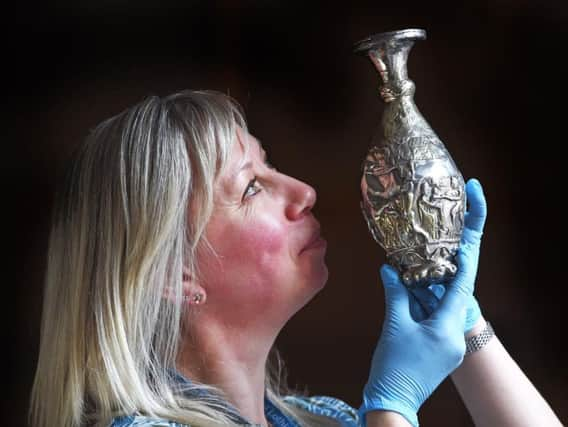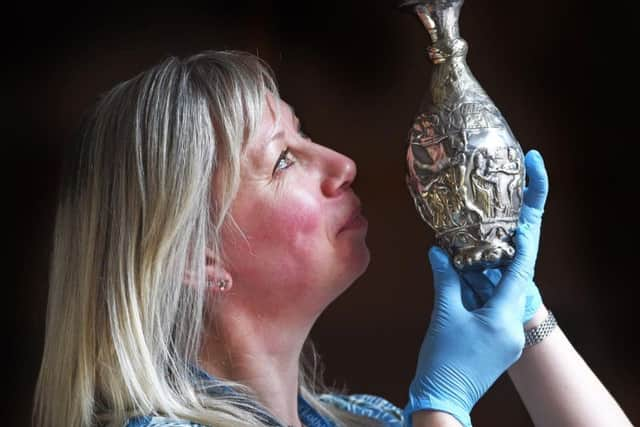Stunning hoard of Roman silver goes home to East Lothian


Around 23kg of silver was discovered by archaeologists at Traprain Law near Haddington in May 1919 with the hoard still considered to be the largest of its kind found outside the Roman Empire.
Most of the objects are hacked up pieces table silver although Christian objects, articles from a lady’s dressing-table and pieces from an officer’s uniform were also found.
Advertisement
Hide AdAdvertisement
Hide AdThe pieces - some 250 in total - were buried around the mid-5th Century in the “dying days” of the Roman Empire.


The valuables are thought to have been earlier gifted by the Romans to a prominent figure in the surrounding Iron Age community of East Lothian as the occupying force sought to make connections and allies in Scotland.
Later, it is likely they were buried for safekeeping.
Now, a selection of pieces from the Traprain Treasure, which is held by National Museum of Scotland, will go on show in Haddington, around five miles from where it was found, to mark the 100th anniversary of its discovery.
Dr Fraser Hunter, Principal Curator of Iron Age and Roman collections, said: “The Traprain Treasure is the most significant silver find from beyond the Roman frontier right across Europe.
“The treasure can only really be described in superlatives. It is the biggest and the best hoard that has been found anywhere across Europe.
“It is 23 kg of silver and when you see it all together, it looks stunning
“It is absolutely awe inspiring and you really recognise the power of silver when you see it.
“We are delighted to be supporting its display in East Lothian, which is a fitting way to mark the centenary of its discovery”
Advertisement
Hide AdAdvertisement
Hide AdDr Hunter, author of The late Roman Silver treasure from Traprain Law, which is due out this summer, said said the hoard was still revealing new insights 100 years after it was found.
Recent research has suggested that the hoard, which contains pieces likely madein the west of Germany or north of the Pennines, was deposited at Traprain Law over a period of around 100 years.
Dr Hunter said: “Our best dating is the middle of the 5th Century - this is the dying days of the Roman Empire. The Roman government in Britain has collapsed.
“Our research is showing that the silver is coming onto the site over 100 years - it doesn’t turn up in one go. We know this by the style of the vessels, which changed over time.
“The treasure might have belonged to one family or leader. Material of that quality is likely to have belonged to a powerful person.”
Dr Hunter said there were two schools of though as to why the silver was buried.
“One is that is that when you bury valuables, you are using the earth as a bank. You are putting things in the ground for safe keeping
“The second school of thought is that you are using the earth as a temple. You see this as a place where you can make offerings and you never intend to pick them up.”
Advertisement
Hide AdAdvertisement
Hide AdDr Hunter said it more likely that the Traprain Treasure was left for safekeeping - but the person who left them never returned to collect them.
“Whoever left the treasure, we will never know. Why they never returned for it, we will also never know," he added.
The treasure was found on the site of a once densely settled area inside a yard, where the depositer could have buried the silver out of sight.
The hoard consisted of fragments from over 250 silver objects, that had been cut into set weights of bullion.
During times of economic crisis in the Roman world, precious metal was valued as bullion rather than as fancy vessels.
It was sent north as diplomatic gifts, or payment for military assistance, to the leaders of Traprain Law as a way of buying their support.
Dr Hunter added: “Rome is a brutal colonising power but they are trying to occupy and not just conquer.
"You need to build some sort of relationship with people . Rome is not just trying to crush - they are trying to build connections.”
Advertisement
Hide AdAdvertisement
Hide AdDr Hunter said the silver was always intended for the melting pot with the Roman silver bullion melted down and used to create the first ever pieces of Scottish silver jewellery.”
The Traprain Law silver will go on show at the John Gray Centre, Haddington, on Saturday May 11.
It is the first time the treasures will have returned to East Lothian since they were discovered 100 years ago.
A programme of talks and events are planned to mark the centenary, both in East Lothian and at the National Museum of Scotland.